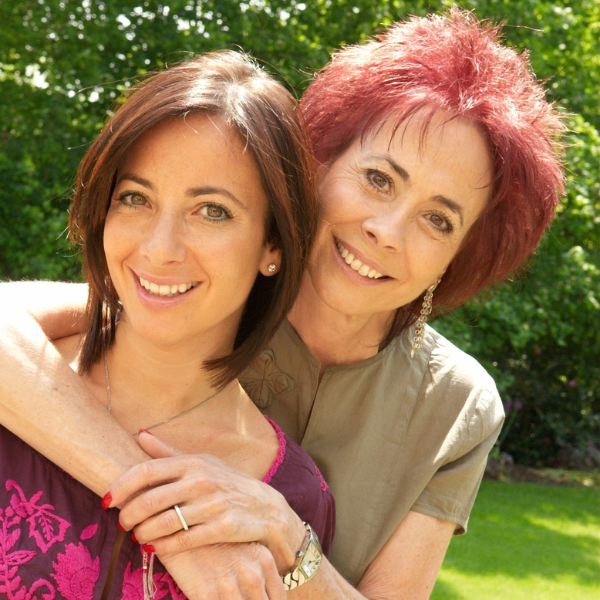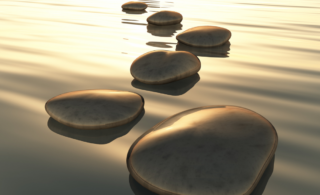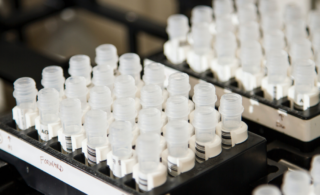
Not everyone chooses to have breast reconstruction after a mastectomy and this article describes one woman’s choice to remain flat following her surgery.
By Juliet
“I’m afraid that you need to have a mastectomy” said the breast surgeon with the dodgy wig who couldn’t meet my eye. This was when the wall of emotions that I’d been carefully building to protect myself from future knocks completely collapsed and I began to sob. Not only would I soon be bald as a result of the chemotherapy that I’d be starting in a month, but I’d also be one breasted, or a ‘uniboober’ as I came to call my lopsided mammary situation.
A month earlier in January 2016, I’d been diagnosed with Grade 2 breast cancer in my left breast, following my second routine mammogram, at the age of 54. My treatment was to be a lumpectomy and radiotherapy. The doctors thought that the tumour was only 20mm. How little did they know!!

It turned out that the tumour was Grade 3, multifocal (in lots of places throughout my breast) and was actually 70mm in total. During the lumpectomy, the surgeons couldn’t get a large enough clear margin around the tumour and this was why I had to have a total mastectomy. After being told that I’d have to have my left breast cut off, I was shown one of the scariest video shows that I’d ever seen.
Supposedly helpful and informative, but in reality, gruesome after and after photos. I think they were actually called before and after, but I like to think of them as after mastectomy – numb, flat chested with no nipples – and after reconstruction – numb, breast shaped chest with no nipples.
I would have to have the DIEP flap breast reconstruction to rebuild my GG cup breast. It was sold to me as a tummy tuck on the NHS. I would definitely go down a jeans size after the 8-hour operation which would leave me with a hip to hip scar and a “breast” fashioned from my own fat from my stomach. Oh yes, and no nipple – that would have to be added later.
The options available after a mastectomy:
There was no mention of the other option – not having reconstructive surgery.
I now wonder why all women and men who have to have a mastectomy aren’t given all of the options?
- Reconstruction, or
- Breast reduction balancing surgery, or
- No reconstruction and remain flat.
I wasn’t offered all of those options, so was unable to make an informed choice about my treatment after mastectomy. So, I agreed to reconstruction, because I didn’t know that there was another option.
I was also told that I’d have to wait for 12 months after my radiotherapy had finished. As it turned out, the enforced delay was a gift for me as it gave me time to think. I clearly remember having one of those light bulb moments after Googling “does anyone not have breast reconstruction after mastectomy”.
I found the Flat Friends website and public Facebook site, and I felt that I had found some kindred spirits. There were women out there who had chosen not to have reconstruction and were living happily as uniboobers or completely flat. This was a total revelation to me and I knew immediately that this was the route I would go down. It was so wonderful to realise that I wasn’t a freak for wanting to live without a replacement breast. I felt that I was pushed down the reconstructive surgery route and, while this is right for some women, it wasn’t right for me.
Choice is the most important part of this discussion. A woman’s right to have autonomy over her own body. And a woman’s right to feel listened to and supported by her health care professionals. My husband, grown up son and daughter were so supportive of my decision. They were mostly glad that I was still here to make it.
My mastectomy
After my mastectomy in March 2016, it took me a few days before I could look at the flat side of my chest and I really doubted my decision not to have reconstruction. As the days and weeks went on though, it became easier to look at and I got used to seeing a scar where my breast used to be.
What I couldn’t get used to was my GG cup remaining breast. I hated being so lopsided and it took a long time to become used to wearing my huge silicone prosthetic breast. It was heavy and so big that it didn’t fit properly in the pocket in my bra. In fact, it migrated to the centre of my chest most days and was clearly visible poking up at the top of my bra – very unattractive. I did wear it every day but really looked forward to taking my bra off with my breast attached to it at the end of the day – it certainly made a thud as it hit the floor!
In November 2017, eighteen months after my first mastectomy, I had my second breast removed. My surgeon had finally agreed to remove my healthy breast after I had persuaded him that I wanted to be symmetrical. I did have to visit a psychologist though, just in case I was not of sound mind and wasn’t aware of what I was asking.
Why I love living flat
I’ve been living flat for just over a year…and I love it! Here are some reasons why:
• I took control of a very bad situation and turned the negative into a positive.
• I feel empowered by making decisions about my body. I love the feelings of being confident, brave and strong that have flowed from that decision making.
• I enjoy challenging society’s definition of beauty.
• I’ve discovered that having breasts didn’t define me as a woman. I can be just as feminine and beautiful without them.
• I never liked my large breasts – I’m only 5’2” – and I feel now that I finally have the body that I always should have had.
• I don’t get stared at anymore because of my large chest. Amazingly, people don’t look at me anymore even though I’m flat – they just don’t notice.
• Once I realised this it boosted my confidence and self-body image even more.
• I really like the way my body looks now, and I like my scars – they’re part of my history and remind me of what I’ve gone through.
• I’m not carrying around nearly 2kg in weight on my chest any more – moving is so much easier and more pleasurable.
• I’ve been freed from wearing a bra & all that entails. I haven’t worn one since last November 2017.
• But I have the choice to wear a bra and have whatever size breasts I want. I’ve got some lovely C cup prostheses.
• I’m able to play sport without feeling like my chest was so constricted by my sports bra that I couldn’t breathe.
Since I made the choice to live flat, I’ve done some amazing things which have pushed me out of my comfort zone, the first of those being a topless photo shoot with Sue Lacey, a photographer friend of mine. I started to write my blog, www.bloomingcancer.co.uk, as a way of showing these photos and starting to break down the taboo of flatness, but also as the start of my advocacy for choice after mastectomy. I’ve had media coverage too. A feature in Good Housekeeping, which included one of my topless photos in the article, and I was guest editor on BBC 5 Live’s Afternoon Edition with Nihal Arthanayke, debating the right to choose after mastectomy. Following that, I made a video for the BBC.co.uk homepage. It was the most watched video that day. I took part in Sophie Mayanne’s Behind the Scars photography project, again showing my scars and aiming for normalisation of a flat female chest. And I recorded my first podcast with Very Loose Women.
I love doing all of this, but the reason that I push myself do it all is to get the message out that it’s OK to live flat. I’m alive and that is way more important to me than having breasts.
Further information
To return to the homepage of our Information Hub, click here where you can access more helpful information, practical advice, personal stories and more.

Future Dreams hold a range of support groups, classes, workshops and events to help you and your carers during your breast cancer diagnosis. These are held both online and in person at the London-based Future Dreams House. To see what’s on offer and to book your place, see here.
January 2019 (Reviewed February 2023)
This article was written by a guest author based on their own experience of breast cancer and its treatment. It is important to note that this is one person’s experience and that whilst there may be commonalities between the experiences of different people, everyone has a different diagnosis/treatment plan/general experience. The information and content provided in all guest articles is intended for information and educational purposes only and is not intended to substitute for professional medical advice. It is important that all personalised care decisions should be made by your medical team. Please contact your medical team for advice on anything covered in this article and/or in relation to your personal situation. Please note that unless otherwise stated, Future Dreams has no affiliation to the guest author of this article and he/she/they have not been paid to write this article. There may be alternative options/products/information available which we encourage you to research when making decisions about treatment and support.
Share

Support awareness research
Donate to those touched by BREAST cancer
Sylvie and Danielle began Future Dreams with just £100 in 2008. They believed nobody should face breast cancer alone. Their legacy lives on in Future Dreams House. We couldn’t continue to fund support services for those touched by breast cancer, raise awareness of breast cancer and promote early diagnosis and advance research into secondary breast cancer without your help. Please consider partnering with us or making a donation.



